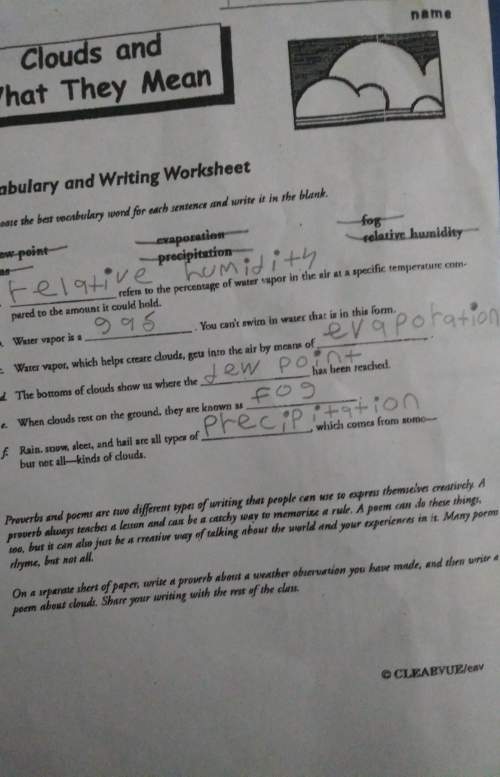
Physics, 24.10.2019 20:43 sonykorah7279
You are exploring a newly discovered planet. the radius of the planet is 6.90 × 107 m. you suspend a lead weight from the lower end of a light string that is 4.00 m long and has mass 0.0280 kg. you measure that it takes 0.0615 s for a transverse pulse to travel from the lower end to the upper end of the string. on earth, for the same string and lead weight, it takes 0.0330 s for a transverse pulse to travel the length of the string. the weight of the string is small enough that its effect on the tension in the string can be neglected.

Answers: 1
Another question on Physics

Physics, 21.06.2019 23:30
Jessie ran 5000 meters from the cops and an average speed of 6 meters / second before he got caught . how long did he run?
Answers: 1

Physics, 22.06.2019 08:00
If a balloon is taken outside on a very cold day, what will occur?
Answers: 1

Physics, 22.06.2019 08:30
Red’s momentum vector before the collision is green’s momentum vector after the collision. question 1 options: equal to shorter than longer than question 2 (1 point) saved since green bounces off red, this must be an collision. question 2 options: explosion elastic inelastic question 3 (1 point) red transfers of its momentum to green during the collision. question 3 options: none all little most question 4 (4 points) why does red transfer all its momentum to green? back up your answer with information from the simulation. write at least 2 sentences. question 4 options: skip toolbars for . more insert actions. more text actions. more paragraph style actions. question 5 (1 point) now make red much heavier than green. answer the questions below to describe how both red and green behave after the collision. question 5 options: slowed down sped up kept the same velocity question 6 (1 point) green sped up during the collision as it question 6 options: gained momentum from red lost momentum to red maintained a constant momentum. question 7 (1 point) after the collision . . question 7 options: both green and red moved to the right. both green and red stopped as they have lost all momentum. red stopped and green moved to the right. red bounced off green and went to the left. green moved to the right. question 8 (4 points) only some of red’s momentum was transferred to green. why did this occur? back up your answer with information from the simulation. write at least 2 sentences. question 8 options: skip toolbars for . more insert actions. more text actions. more paragraph style actions. question 9 (1 point) now make red much lighter than green. answer the questions below to describe how both red and green behave after the collision question 9 options: green sped up after the collision therefore it must have gained momentum. green sped up after the collision therefore it must have lost momentum. green slowed down after the collision therefore it must have gained momentum. green slowed down after the collision therefore it must have lost momentum. question 10 (1 point) since green gained momentum, red had to have momentum because you cannot create or destroy momentum. question 10 options: gained lost kept the same amount of question 11 (1 point) since green was so much and harder to move, it caused red to bounce back to the left giving red . question 11 options: heavier . . . . positive lighter. . . . negative lighter. . . . positive heavier . . . . negative question 12 (4 points) now, click on more data at the bottom of the sim. play with different numbers for the masses and starting velocities. you can even make the starting velocities negative! tell me one thing you discovered by adjusting the speeds and masses. write at least 2 sentences. be specific and use words like velocity, momentum, mass, increased, decreased, etc. 13. true or false: when red and green collide, they stick together. question 13 options: true false question 14 (1 point) the velocity of red & green after the collision is the velocity that red started off with. question 14 options: larger than smaller than equal to question 15 (1 point) the velocity after the collision was less because the mass has question 15 options: stayed the same decreased increased question 16 (1 point) the momentum before the collision was the momentum after the collision. question 16 options: larger than smaller than equal to conclusions question 17 (4 points) how are elastic and inelastic collisions different? give two or more ways. your answer should have at least 2 sentences. question 18 (4 points) give an example of a collision in real life. use the law of conservation of energy to describe the transfer of momentum. be sure and discuss the momentum before and after the collision occurs. you will need at least 3 sentences to thoroughly answer this question.
Answers: 2

Physics, 22.06.2019 15:20
Arigid tank is divided into two equal parts by a partition. one part of the tank contains 3 kg of compressed liquid water at 400 kpa and 60°c while the other part is evacuated. the partition is now removed, and the water expands to fill the entire tank. determine the entropy change of water during this process, if the final pressure in the tank is 40 kpa. use steam tables.
Answers: 3
You know the right answer?
You are exploring a newly discovered planet. the radius of the planet is 6.90 × 107 m. you suspend a...
Questions

English, 03.03.2021 04:10



History, 03.03.2021 04:10


English, 03.03.2021 04:10



History, 03.03.2021 04:10

Health, 03.03.2021 04:10

Chemistry, 03.03.2021 04:10



Computers and Technology, 03.03.2021 04:10

Social Studies, 03.03.2021 04:10



Mathematics, 03.03.2021 04:10





